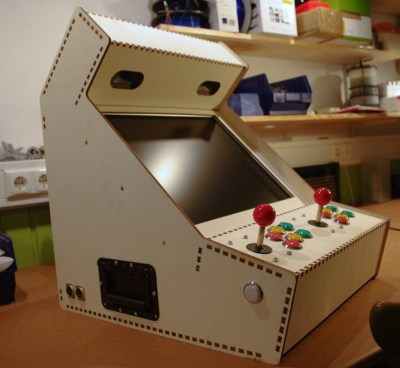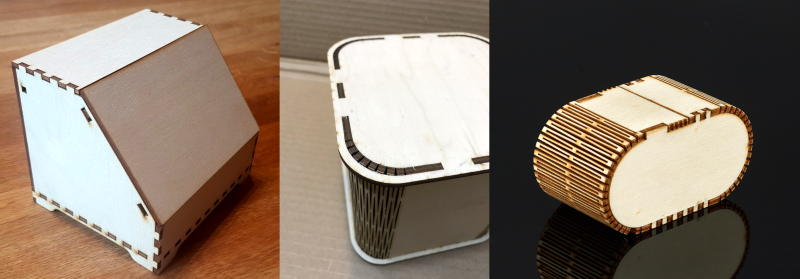I needed something to test out a low-power laser cutter, and thought that some small cardboard boxes would fit the bill nicely, so off I went to scour the Interwebs for a quick-and-dirty finger-joint box generator. And the best of the best was to be found, drumroll please, on Hackaday.io. [Florian Festi]’s boxes.py not only has a sweet web interface, covers an absurd number of box styles, and includes kerf tests to ensure that your joints are tight, but it’s also written in easy-to-extend Python for when you have really particular needs.
 But you won’t need to design anything of your own. There are already boxes with living hinges, boxes that fit 19″ racks, Eurorack skiff boxes with laser-cut mounting rails, and even a generic electronics project box with mounting ears for your PCB. Console2 has integrated clips on the rear service hatch.
But you won’t need to design anything of your own. There are already boxes with living hinges, boxes that fit 19″ racks, Eurorack skiff boxes with laser-cut mounting rails, and even a generic electronics project box with mounting ears for your PCB. Console2 has integrated clips on the rear service hatch.
You need a pentagonal prism with a round opening? What size? I guess a complete arcade-style console is technically a box. Naturally, there are also geartrains and even a robot arm design. Wait, what?
Each of the box designs is fully customizable, so it’s easy to make something like a box with customized dividers, where the different compartments are specified in a sweet text markup. [Florian]’s example box set for the game Agricola is amazing.
Underpinning the code is a LOGO-like finger-joint drawing routine. This makes it relatively easy to draw your own funny shapes, and have the hard work of thinking through the joining fingers taken care of by the computer. [Florian] seems open to taking pull requests for new box shapes, but I haven’t thought of one yet.
I can’t say enough about how cool boxes.py is, and most of the demo applications are worth a look on their own. This was an entry in the Hackaday Prize back in 2017, and it’s been growing and improving ever since. Way to go, [Florian] and Co.
















Nice! Anyone know of something similar for cardboard boxes?
Why wouldn’t it work for cardboard boxes?
Because cardboard boxes can fold, while boxes.py is more for solid construction with finger joints. Something similar that produces templates/dielines for cardboard boxes would be great. For example https://www.templatemaker.nl/ but this has a limited selection, and doesn’t include my personal favourite roll-end tuck-front box (no glue, just folds, locks together) eg https://www.lumi.com/styles/roll-end-tuck-front-retf
According to the article, this project supports “boxes with living hinges”.
Living hinges are those repeated slit things used to put a curve in plywood or acryllic. Cardboard, corrugate, and coroplast don’t need them since they can actually be scored and folded.
Don’t know anything for fold-up cardboard boxes, but gluing up the finger joints works fine on cardboard. I made a few for sorting / holding pens, and they work fine.
Just recently the PaperBox generator was submitted by a contributor. It can be found in the Misc section. I am not sure if it will work with thick (corrugated) card board. Feel free to open tickets if there is more work needed.
What’s the cheapest usable laser for wood?
Chinese k40 but be prepared to put some time in to make it safe (I use the term safe very loosely) and functional. Would not recommend it for complete novice without much electrical or laser safty awareness as it can be quite dangerous.
And make sure to check *all* the wiring, including the crimped on ferrules on the low voltage bits, I found several of them weren’t crimped properly on mine.
DIY. https://www.thingiverse.com/thing:4645406 is a pretty nice design, cheap, and you might already have parts laying around. With a decent aquarium air pump as an air assist and an inexpensive Neje 20W (input) laser module, I cut 3mm/5mm plywood with ease in one pass.
Even cheaper if you have steppers and a controller lying around, especially if you have/have access to a 3D printer.
I’m using a “7.5 W” laser, which is actually a 2.5 W. Poplar plywood (“Pappelsperrholz” in German) works OK, but requires a few passes, and it’s super slow. I’ve had some problems when the cut passes over a knot in the wood.
You really want a K40 if you’re going to be doing a lot of wood. It’s sufficient for thin plywood and fast.
The one in your local maker space.
You’re a couple days too late to save me from writing my own OpenSCAD library for parametric shelf with drawer boxes. Might as well finish it now. Went and learned all the bits and did the hard coding parts for layout display and printing.
Ancillary question, though. Anyone else notice that Google’s abysmal for searching on anything but gossip delivered via YouTube video? I definitely spent enough time looking that I should have found a library started in 2017!
Yes, same issues, nothing like having to watch 20 seconds of a yt vid before stopping and going to the next and next to find anything usefule. But then, gurgle is an advertisement company and political action agency, so go figure.
There are loads of boxmakers around, some web based, some as inkscape plugins and I’m sure on many other platforms.
True! Too many, as it turned out. Brendan’s nice lasercut sheet library below was the only one that came up that was fully functional (with my search terms, obviously).
I started massaging it to do what I needed but decided I was too unfamiliar with OpenSCAD’s limitations to heavily modify someone else’s (tightly written) design to work for me.
The requirement was for a shelving unit with drawers and multiple levels that’d be completely parametric. And then go and arrange itself for lasercutting in a sane manner. This library still doesn’t seem perfect but as it’s Python and it contains all the functions you would want I could’ve thrown in patches for another design.
https://github.com/bmsleight/lasercut/
Openscad library
If anyone is interested in a cad version tutorial, I made one for my first robotics team the other week. https://youtu.be/dUzFAMSbqQo